注释、变量和基本数据类型
1. NotePad设置
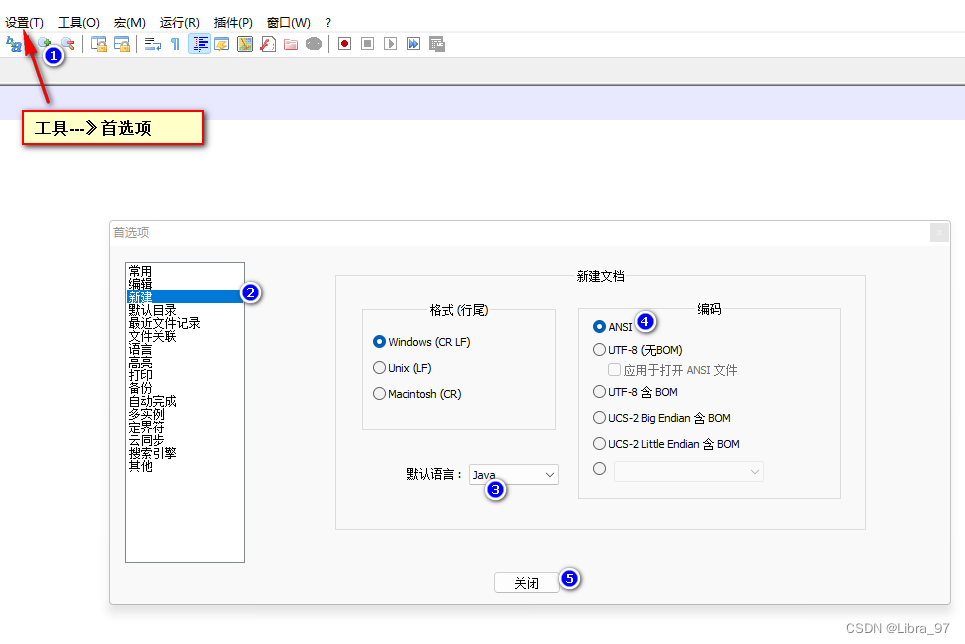
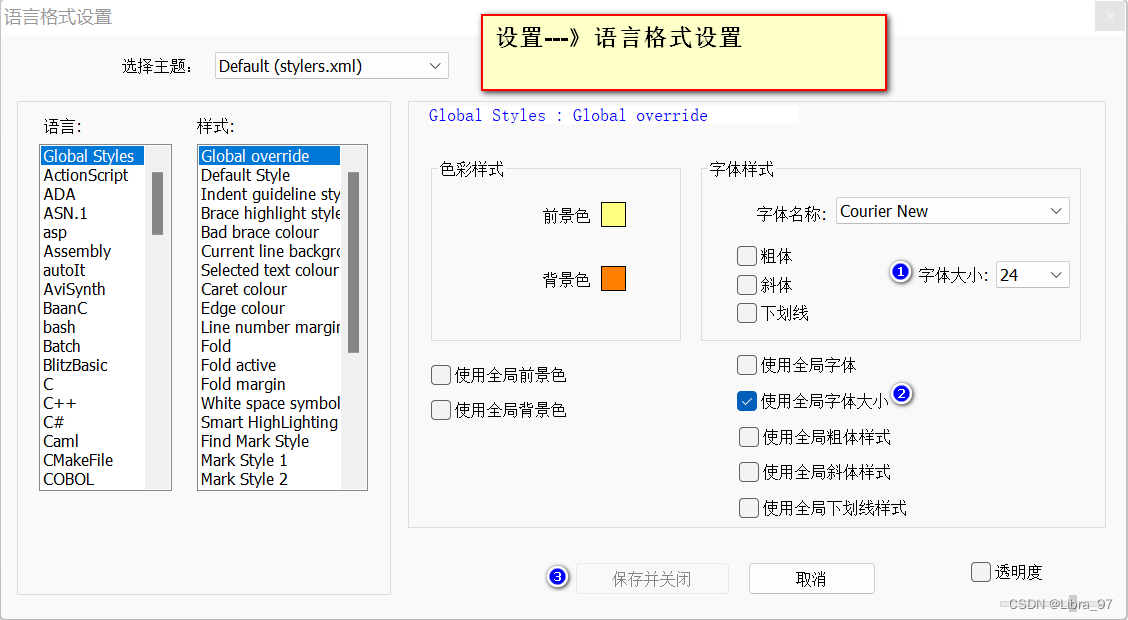
2. 注释
单行注释://
多行注释:/* */
文档注释:(生成外部文档:javadoc -d . HelloWorld.java)
/**
*/
注:注释不参与编译。
/**
* 文档注释 document:文档
* 可以生成帮助文档
* 此类用于演示讲解文档注释
*/
public class Test1{
/**
* 此方法为main方法 main方法为程序的入口
* 程序如需执行 必须有main方法
*
*/
public static void main(String [] args){
/*
多行注释
*/
System.out.println("文档注释测试"); // 单行注释
}
}
变量和运算符
1. 关键字
被Java语言赋予了特殊含义,用做专门用途的单词 关键字中所有字母都为小写
注意:取名字避免和关键字冲突
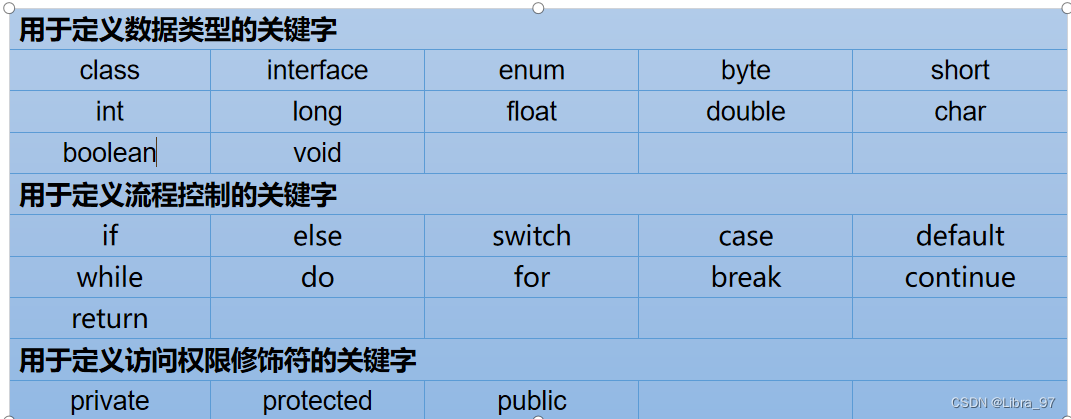
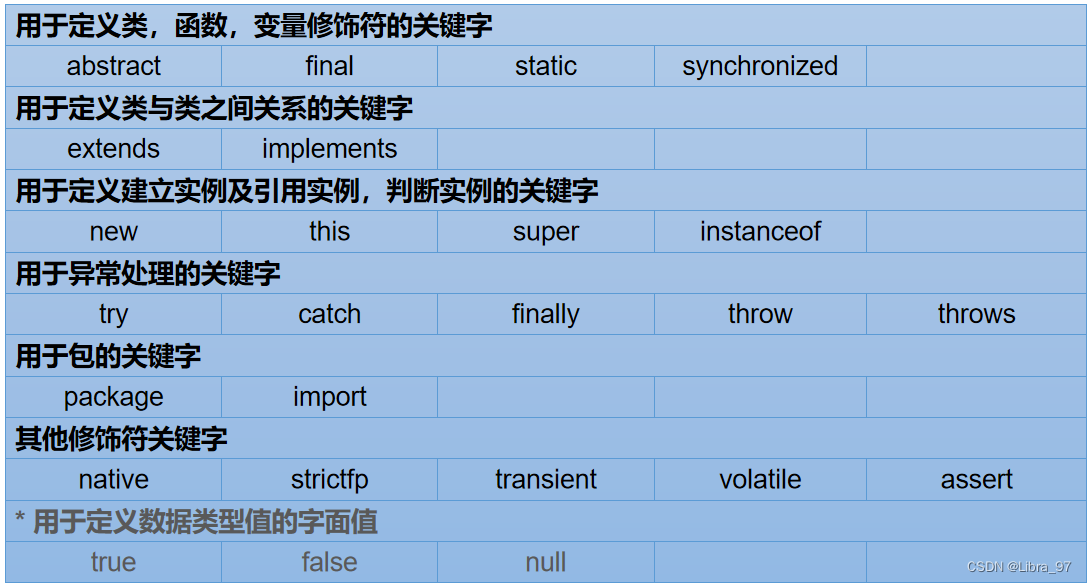
2. 保留字
Java保留字:现有Java版本尚未使用,但以后版本可能会作为关键字使用。自己命名标识符时要避免使用这些保留字 goto 、const
注意:取名字避免和保留字冲突
3. 标识符
Java 对各种变量、方法和类等要素命名时使用的字符序列称为标识符
总结:凡是自己可以起名字的内容都称之为标识符。
标识符命名规范:
1.类名首字母大写
4. 变量的引入
比如:你的同桌需要大宝剑,发现钱不够,找你借5毛钱
时间:2022年8月31号
地点:教室
人物:你的同桌
事件:借钱
金额:0.5元/5毛
在现实生活中,我们通常需要记录数据,记录数据的方式多种多样,比如:视频、音频、图片、文字等等
在程序中我们通过变量来记录数据(
变量就是用来记录数据的)在生活中的数据有各种各样的数据类型,程序中也同样,
不同的数据使用不同的数据类型来保存
5. 变量的定义方式
声明变量的3种方式:
先声明,再赋值:【常用】
数据类型 变量名;
变量名 = 值;声明并赋值:【常用】
数据类型 变量名 = 值;多个同类型变量的声明与赋值:【了解】
数据类型 变量1 , 变量2 , 变量3 = 值3 , 变量4 , 变量5 = 值5;
/**
* 此类用于讲解变量的三种定义方式
1.先声明 再赋值
2.连声明带赋值
3.同时声明多个同类型的变量(了解)
*/
public class Test1{
public static void main(String [] args){
// 变量是用来存储数据的
// int类型的变量只能用于保存整数
// 方式1 先声明 再赋值
int a;
a = 100;
// 任何内容与字符串相加 视为拼接字符串 不做计算
System.out.println("变量a中存储的值为:" + a); // 变量a中存储的值为:100
// 方式2 连声明带赋值
int b = 66;
System.out.println("变量b中存储的值为:" + b); // 变量b中存储的值为:66
// 方式3 同时声明多个同类型的变量(了解)
// 这行代码 e取值55 g取值88 其他三个变量未赋值
int c, d, e = 55, f, g = 88;
System.out.println("变量e的取值为:" + e); // 变量e的取值为:55
System.out.println("变量e的取值为:" + g); // 变量e的取值为:88
// System.out.println("变量c的取值为:" + c); // 编译报错 错误: 可能尚未初始化变量c
// System.out.println("变量d的取值为:" + d); // 编译报错 错误: 可能尚未初始化变量d
// System.out.println("变量f的取值为:" + f); // 编译报错 错误: 可能尚未初始化变量f
}
}
6. 单位换算
1TB = 1024GB
1GB = 1024MB
1MB = 1024KB
1KB = 1024Byte(字节)
1Byte = 8bit(位)
1个字节占8位,可以理解为1个字节有8个小格子,每一个格子分别可以存储一个0或者一个1
1WORD = 2Byte 1个词等于两个字
7. 数据类型
7.1 整型
整数类型 :一个整数默认的数据类型为int类型
int为整数的默认类型,
如需为long类型赋值
如果取值范围超过了int的取值范围 必须在值的后面追加“L” 大小写都可以 推荐大写
如果取值范围没有超过int的取值范围 L 可加可不加
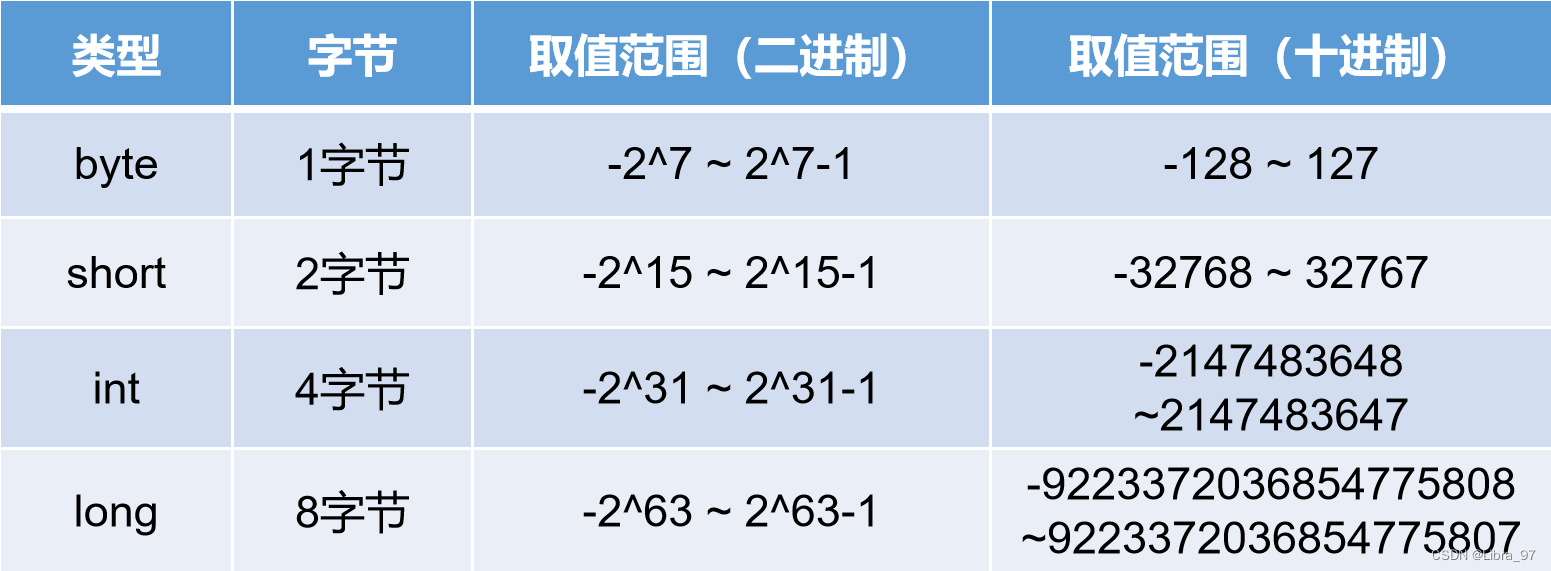
public class Test1{
public static void main(String [] args){
// 整数类型:一个整数默认的数据类型为int类型
// byte 1个字节 -128 ~ 127
byte b1 = 120;
System.out.println("b1的取值为:" + b1); // b1的取值为:120
byte b2 = -128;
System.out.println("b2的取值为:" + b2); // b2的取值为:-128
// byte b3 = 128; // byte类型不能超过127 编译错误: 不兼容的类型: 从int转换到byte可能会有损失
// System.out.println("b3的取值为:" + b3);
// short 2个字节 -32768 ~ 32767
short s1 = 2456;
System.out.println("s1的取值为:" + s1);
short s2 = 32767;
System.out.println("s2的取值为:" + s2);
// short s3 = -32769; // short类型不能超过-32768 编译错误: 不兼容的类型: 从int转换到short可能会有损失
// System.out.println("s3的取值为:" + s3);
System.out.println("-------------------");
// int 4个字节 -2147483648 ~ 2147483647
int i1 = 2348798;
System.out.println("i1的取值为:" + i1);
int i2 = 2147483647;
System.out.println("i2的取值为:" + i2);
// int i3 = 2147483648; // int类型不能超过2147483647 编译错误: 过大的整数: 2147483648
// System.out.println("i3的取值为:" + i3);
System.out.println("-------------------");
// long 8个字节 -9223372036854775808 ~ 9223372036854775807
// int为整数的默认类型
// 如需为long类型赋值
// 如果取值范围超过了int的取值范围 必须在值的后面追加L或l 大小写都可以 推荐大写
// 如果取值范围没有超过int的取值范围 L可加可不加
System.out.println("long类型最大取值为:" + Long.MAX_VALUE);
System.out.println("long类型最小取值为:" + Long.MIN_VALUE);
long l1 = 1234L;
System.out.println("l1的取值为:" + l1);
// long l2 = 1249072395472; // 取值范围超过了int的取值范围,没加L 编译错误: 过大的整数: 1249072395472
// System.out.println("l2的取值为:" + l2);
long l3 = 1249072395472L; // 加上L就不会报错了
System.out.println("l3的取值为:" + l3);
}
}
7.2 浮点类型
浮点类型 float和double都是近似值 不是精确值
注意:double为浮点数的默认类型,如需为float类型赋值,需要在值的后面追加“F”

public class Test1{
public static void main(String [] args){
// 浮点类型 float和double都是近似值 不是精确值
// float 负数 -3.4E+38(-3.4 * 10^38) ~ -1.4E-45(-1.4 * 10^-45)
float f1 = -340000000000000000000000000000000000000F;
System.out.println(f1); // -3.4E38
float f2 = -0.0000000000000000000000000000000000000000000014F;
System.out.println(f2); // -1.4E-45
// float 正数 1.4E-45(1.4 * 10^-45) ~ 3.4E+38(3.4 * 10^38)
float f3 = 0.0000000000000000000000000000000000000000000014F;
float f4 = 340000000000000000000000000000000000000F;
System.out.println(f3); // 1.4E-45
System.out.println(f4); // 3.4E38
// double 如果double类型赋值超过float取值范围 需要在值的末尾加上D
double d1 = 23.5;
System.out.println(d1); // 23.5
// double d2 = 999999999999999999999999999999999999; // 超过float取值范围了,末尾没加D 编译错误: 过大的整数: 999999999999999999999999999999999999
// System.out.println(d2);
double d3 = 999999999999999999999999999999999999D; // 超过float取值范围了,末尾没加D 编译错误: 过大的整数: 999999999999999999999999999999999999
System.out.println(d3); // 1.0E36
}
}
7.3 布尔类型

可直接赋值true / false
也可赋值一个结果为true / false的表达式
注意:Java中的boolean不能参与算数运算
public class Test1{
public static void main(String [] args){
// 布尔类型 仅能取值 true 真/ false 假
boolean b1 = true;
boolean b2 = false;
System.out.println(b1); // true
System.out.println(b2); // false
System.out.println("-------------------------------------");
int a = 100;
int b = 200;
boolean b3 = a > b;
System.out.println(b3); // false
boolean b4 = a < b;
System.out.println(b4); // true
}
}
7.4 字符类型
Unicode字符集支持ASCII编码(美国标准信息交换码)。
Unicode中每个字符都对应一个十进制整数,从而可以使用多种方式赋值。字符赋值:char c1 = ‘A’;(通过’'描述为字符赋值)
整数赋值:char c2 = 65;(通过十进制数65在字符集中对应的字符赋值)
进制赋值:char c3 = ‘u0041’;(通过十六进制数41在字符集中所对应的字符赋值)

public class Test1{
public static void main(String[] args){
// 字符类型 取值范围 0 ~ 65535 无符号数
// 3种赋值方式
// 方式1 直接使用英文单引号包括任意一个内容
char c1 = 'a';
char c2 = 'B';
char c3 = '1';
char c4 = '中';
System.out.println(c1); // a
System.out.println(c2); // B
System.out.println(c3); // 1
System.out.println(c4); // 中
System.out.println("-------------------------------------------");
// 方式2 直接赋值取值范围在0 ~ 65535之间(包括0和65535)的整数
// 如果给char类型直接赋值0 ~ 127范围内的整数 将从ASCII码表中找到对应字符
// 如果超出0~127这个范围,将参考Unicode编码表
// Unicode编码表 是 万国码
// 这张表中记录了世界上大多数国家语言 是以16进制的形式保存字符的
// 中文的取值范围为 u4e00 ~ u9fa5
// ASCII码表 美国标准信息交换码
char c5 = 65;
char c6 = 66;
System.out.println(c5); // A
System.out.println(c6); // B
char c7 = 67;
System.out.println(c7); // C
System.out.println("-------------------------------------------");
char c8 = 20013;
System.out.println(c8); // 中
char c9 = 20333;
System.out.println(c9); // 佭
// 方式3 直接使用十六进制 Unicode字符集赋值
char c10 = 'u4e00';
char c11 = 'u4e2d';
System.out.println(c10);
System.out.println(c11);
}
}
8. 转义字符
Java采用了转义字符来表示单引号和一些特殊符号。
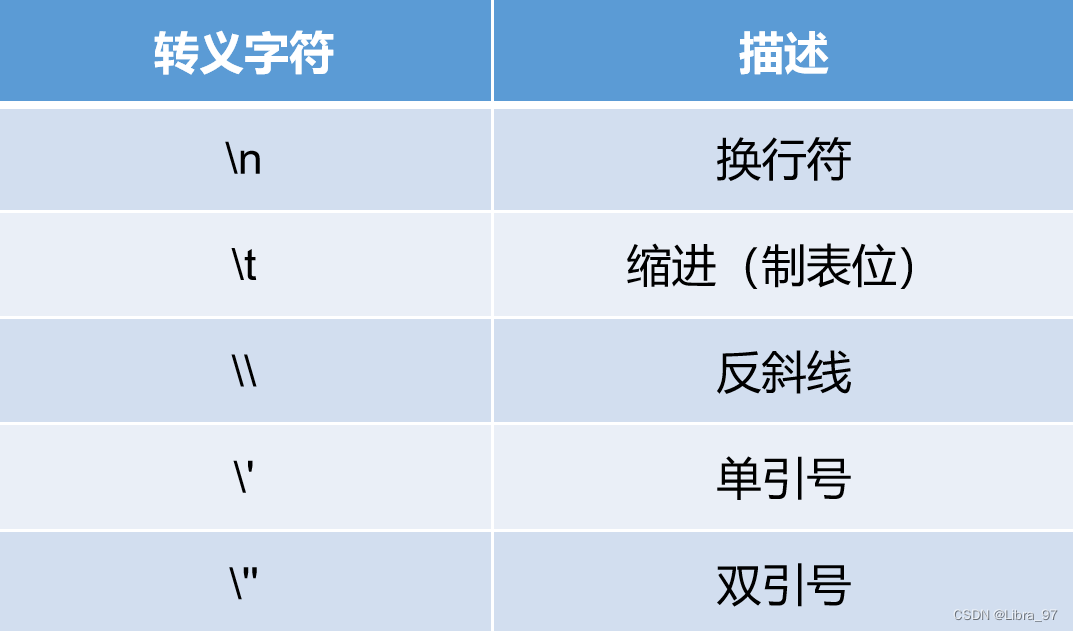
public class Test1{
public static void main(String [] args){
// 转义字符
// 这里使用转义字符' 表示将单引号作为普通文本保存
// 不再具有单引号实质的作用
char ch1 = ''';
System.out.println(ch1); // '
// 换行 println n
System.out.println("abcndefnfgh");
/*
abc
def
fgh
*/
System.out.println("abcndefnfgh2");
/*
abc
def
fgh2
*/
// 制表位 制表符 t 可以在大多数情况下保证上下两行文字对齐
System.out.println("床t前t明t月t光"); // 床 前 明 月 光
System.out.println("疑t是t地t上t霜"); // 疑 是 地 上 霜
// \ 保存一个斜线
char ch2 = '\';
System.out.println(ch2); //
// " 是否转义都可以保存
char ch3 = '"';
System.out.println(ch3); // "
}
}
9. String类型
String 类型 引用数据类型 任何英文双引号包括的内容都是字符串
public class Test1{
public static void main(String [] args){
// String 类型 引用数据类型 任何英文双引号包括的内容都是字符串
String str1 = "abc";
String str2 = "hello world";
String str3 = "234 中 as";
System.out.println(str1); // abc
System.out.println(str2); // hello world
System.out.println(str3); // 234 中 as
}
}
10. 代码阅读
public class Test2{
public static void main(String [] args){
// 代码阅读 不能直接将一个short类型的变量存放到char类型中 除非强制类型转换
short s1 = 65; // -32768 ~ 32767
char ch1 = (char)s1; // 0 ~ 65535
System.out.println(ch1); // A
short s2 = -1;
char ch2 = (char)s2; // ?
System.out.println(ch2);
}
}
11. 类型转换
11.1 自动类型转换
自动类型转换:
1.两种类型相互兼容。
2.目标类型(等号左边)取值范围大于源类型(等号右边)
注意:只要符合以上要求即可类型转换 并不需要必须是取值范围相近的两个类型
public class Test1{
public static void main(String [] args){
// 自动类型转换:
// 1.两种类型相互兼容
// 2.目标类型(等号左边)取值范围大于源类型(等号右边)
// 注意:只要符合以上要求即可类型转换 并不需要必须是取值范围相近的两个类型
byte b1 = 10;
short s1 = b1;
System.out.println(s1); // 自动类型提升为short类型 10
System.out.println("----------------");
short s2 = 2356;
int i1 = s2;
System.out.println(i1); // 自动类型提升为int类型 2356
System.out.println("----------------");
int i2 = 8921;
long l1 = i2;
System.out.println(l1); // 自动类型提升为long类型 8921
System.out.println("----------------");
long l2 = 897845;
float f1 = l2;
System.out.println(f1); // 自动类型提升为float类型 897845.0
System.out.println("----------------");
float f2 = 3.5F;
double d1 = f2;
System.out.println(d1); // 自动类型提升为double类型 3.5
System.out.println("----------------");
byte b2 = 120;
double d2 = b2;
System.out.println(d2); // 自动类型提升为double类型 120.0
}
}
11.2 强制类型转换
强制类型转换:
1.两种类型相互兼容。
2.目标类型(等号左边)取值范围小于源类型(等号右边)。
public class Test2{
public static void main(String [] args){
// 强制类型转换:
// 1.两种类型相互兼容
// 2.目标类型(等号左边)取值范围小于源类型(等号右边)
short s1 = 120;
byte b1 = (byte)s1; // short强转成byte类型
System.out.println(b1); // 120
System.out.println("-------------------");
int i1 = 2123;
short s2 = (short)i1; // int强转成short类型
System.out.println(s2); // 2123
System.out.println("-------------------");
long l1 = 234812;
int i2 = (int)l1; // long强转成int类型
System.out.println(i2); // 234812
System.out.println("-------------------");
float f1 = 3.5f;
long l2 = (long)f1; // float强转从long类型 精度丢失,小数被抹去
System.out.println(l2); // 3
System.out.println("-------------------");
double d1 = 22.5;
float f2 = (float)d1; // double强转成float类型
System.out.println(f2); // 22.5
}
}
最后
以上就是心灵美蛋挞最近收集整理的关于day02 注释、变量和基本数据类型的全部内容,更多相关day02内容请搜索靠谱客的其他文章。








发表评论 取消回复